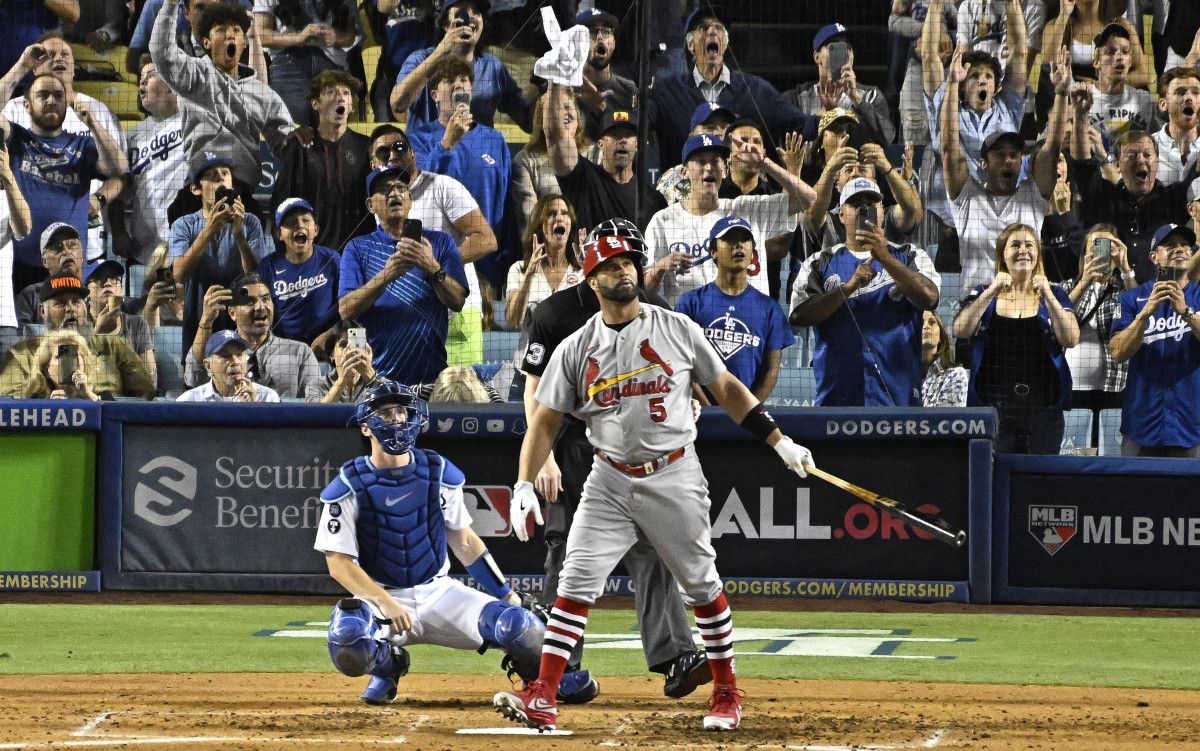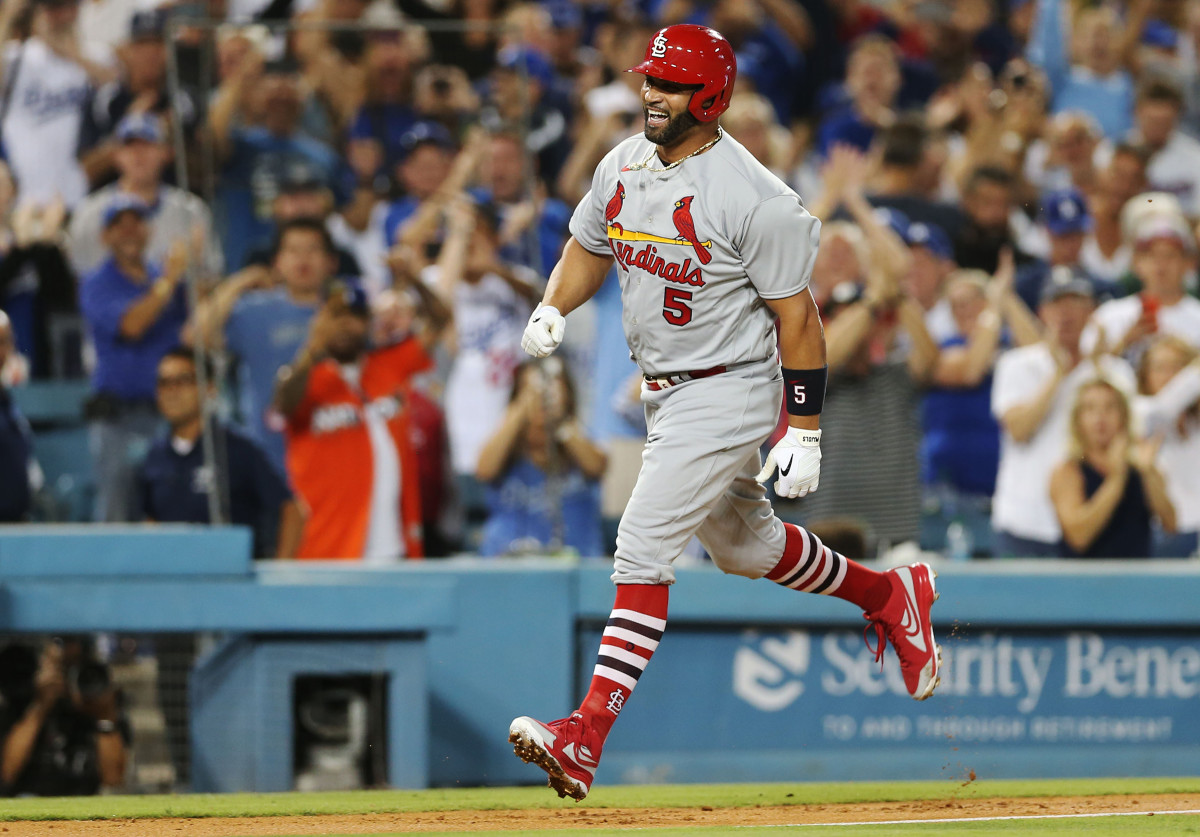Albert Pujols’s 700th Home Run Is the Apex of His Defiant Final Season

The end of baseball days arrives with more cruelness than kindness.
Babe Ruth quit in May 1935 with a .181 average and a feud with the owner of his Boston Braves.
Ken Griffey Jr. was hitting .184 with no home runs in June 2010 when he abruptly left the Mariners by driving home to Florida, leaving only a prepared statement of his retirement.
Mike Schmidt was hitting .203 in 1989 when he quit while the Phillies were in San Diego. Asked what he would miss most about baseball, the great third baseman quipped, “Room service French fries.”
Gravity rules. Such is the commonality of falls from grace that the sight of Albert Pujols smiling broadly—his new game face these days—while circling the bases upon hitting career home run number 700 on Friday night at Dodger Stadium was the happy picture of defiance. Pujols defied time and age, not to mention the normal downward arc of his career, with one of the most spectacular exits the baseball gods ever have permitted.
WELCOME TO THE 7️⃣0️⃣0️⃣ CLUB, ALBERT PUJOLS 👏🏾🦾#Pujols700
— Sports Illustrated (@SInow) September 24, 2022
(🎥: @SNstats) pic.twitter.com/fjexpMJ3ek
Pujols hit home runs 699 and 700 off Dodgers pitchers Andrew Heaney and Phil Bickford, respectively, pitchers 454 and 455 in his home run book with its record number of listings. He joined Barry Bonds, Henry Aaron and Babe Ruth as the only players to reach 700. The way he arrived there was the most stunning of all. Turning the clock back a decade, Pujols’s storming to 700 over the past four months will go down as one of the great mike drops in the game’s history.
On July 5 Pujols was hitting .189 in his role as a part-time player and full-time clubhouse influencer in what was little more than a victory lap season with his Cardinals. Since then, Pujols has been the greatest slugger in the game this side of Aaron Judge, with a slash line of .321/.382/.685. (His slugging percentage had been .411.) His average exit velocity jumped from 89.3 to 92.6.
On Sept. 10, he hit a home run off Pirates righty JT Brubaker like none other he had hit since 2015 when it came to how hard (111 mph) and far (418) it traveled.
The homers Friday night pushed his season totals to 21 homers and a .530 slugging percentage. Only six other players hit 20 homers and slugged .500 in their final season: Bonds, Ruth, David Ortiz, Kirby Puckett, Will Clark and Dave Nilsson. At 42 years and 251 days, Pujols is older than all of them in their last season except for Bonds (43.064).
When I asked Pujols’s manager and long-time friend, Oliver Marmol, how Pujols could turn his season around to such a degree, Marmol mentioned three reasons: 1) he moved closer to the plate, inviting the ball closer to his body to generate more power; 2) he was inspired by the outpouring of love and respect his peers showed him at the All-Star Game; 3) he is content knowing this is his final season, no matter what, including whether he hit 700 or not.

Sandy Koufax knew before the 1966 season it would be his last year playing, but did not tell anybody. Instead, he looked at every game, every ballpark and every day as uniquely special, knowing he would never pass this way again. Pujols, previously and famously stern with his game face, let the days running out on his career be his inspiration, not his fear.
Bickford, his former teammate with the Dodgers, remarked after giving up the milestone homer, “He’s the nicest guy in the world. He’s a big old teddy bear.”
“I’m not chasing anything,” Pujols said earlier this week, when people wondered if the march to 700 was wearing on him, and if he really would leave the game if he fell short of 700.
When Pujols is inducted into the Hall of Fame in five years, it will be his prolific career, not just the surprise of its last three months, that will most be held in awe. Just as Ortiz was celebrated as one of the game’s historic clutch hitters, and not just his 38 homers and .620 slugging percentage in his last year, Pujols will be enshrined as one of the greatest right-handed hitters of all time. He changed the game with his swing, sending current and big league players to batting cages and video tape study sessions to try to replicate that quick, flat stroke and no-leg-kick power. Pujols was a line drive hitter who happened to hit 700 homers—without ever hitting 50 in a season, the same as Aaron. He was a student of hitting from an early age in the Dominican Republic.
“Since I was a little boy I was able to go to the ballpark and at Estadia Quiscaya and watch Julio Cesar Franco play, Raul Mondesi, Sammy Sosa … Winter ball and their workouts,” Pujols once told me. “Because I used to get there early enough. I had the opportunity to work at the stadium with my stepdad—he had a little store in there to sell sandwiches and Coke and beer—so I was able to have an opportunity to go early after school and watch them take BP.”
The swing has evolved over the years, but it began with trying to hit like Franco, staying inside the ball. Pujols grew up competing against kids two to four years older than him, which he told me has led many people to question his age.
“That’s why people when I came here to the states for high school and college they didn’t believe my age,” he told me, “because I was able to mature so early that was able to learn from the mistakes I was making at the age of 13 and 14, playing with guys that were 15, 16 and 17 years old. So I was able to catch those mistakes I was making and playing with them say, ‘O.K., I don’t want to make that mistake. I want to be better.’
“That’s something that helped me out in my career. When I got here to the states, it was amazing. In high school it was almost like playing with kids, pretty much. Everything came easy. I can understand people thought I was older because I was playing with those guys in the DR. At the age of 16 I was tearing up high school ball.”
To get to 700, Pujols hit 500 homers off right-handed pitchers and 200 off left-handed pitchers. Hit hit an amazing 218 homers with two strikes, the most of any hitter since 1988 (Manny Ramirez is next at 192). So much about his career will be defined by never compromising that yin and yang of hitting between power and contact. There was no give to his take. Pujols struck out 93 times as a rookie—and never struck out that many times again, even as baseball saw a record number of strikeouts year after year.

After he hit 700, Pujols slipped into a tunnel behind the visiting dugout at Dodger Stadium and wept.
“Why?” he said, surrounded by his family at his postgame news conference. “Because of this, my beautiful family. After the Lord, this is who I play for. They’ve been walking through this journey and through the ups and downs, through the cries, the hurt and the injuries and knowing they have my back. Them being a part of this history means everything to me.”
Like Ortiz, Pujols will also go down among the most respected players of his generation. His peers admired not just that classic, old-school swing, but his love of the game, his attention to detail. For so many years in his prime Pujols was the template of great hitting. For the last three months of his career, Pujols summoned a return to such greatness. It is the kind of exit from the stage baseball almost never allows. Pujols is leaving the game as he came in: drilling line drives around the field and over the fence, only now with a smile on his face.
More MLB coverage:
• Julio Rodríguez Is Here to Save the Mariners
• The Undeniable Thrill of Waiting for Aaron Judge to Hit 62
• Inside the Drive: The Minor Leaguers Who Sprung a Union on MLB
• How the New Mets are (Mostly) Overcoming Decades of Dysfunction
• Everything in Aaron Judge’s Career Led Him to This Historic Season
